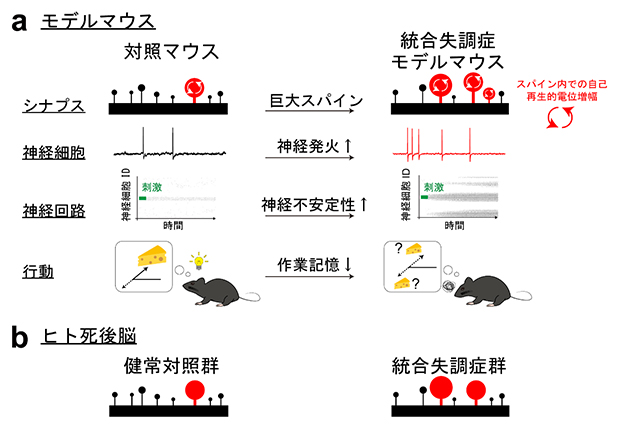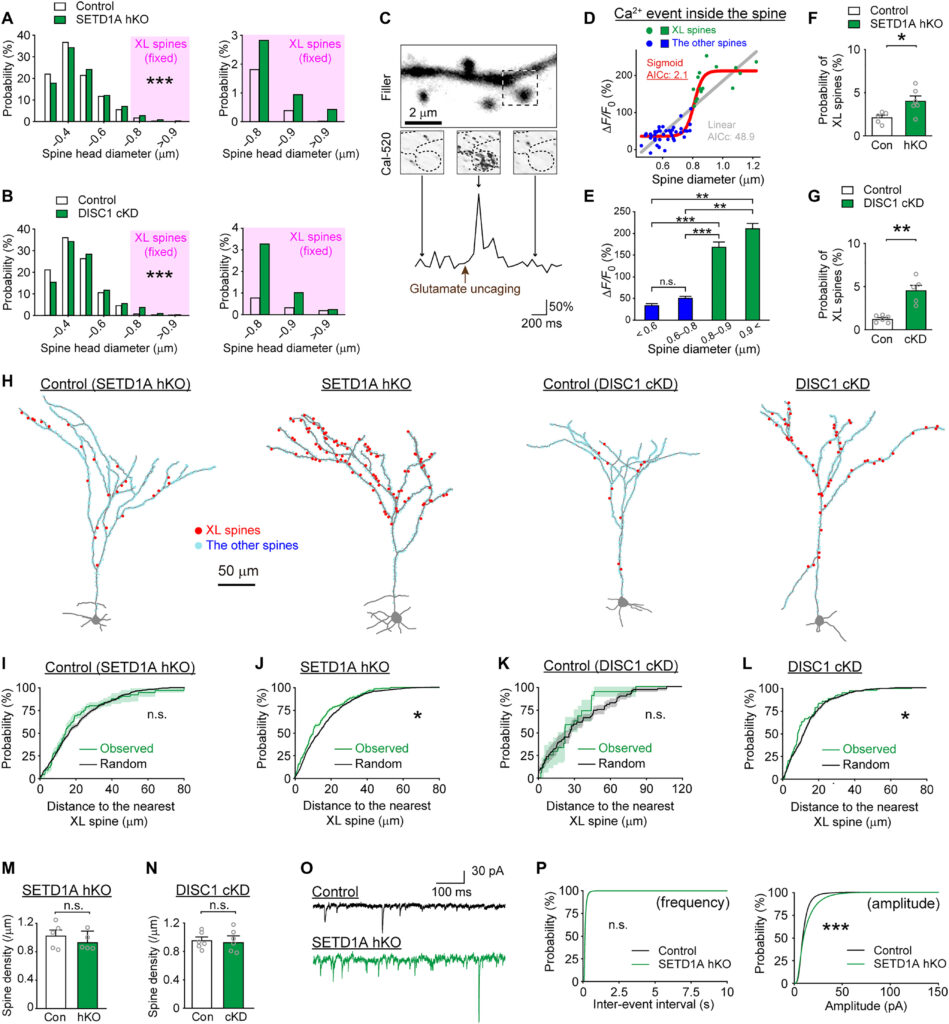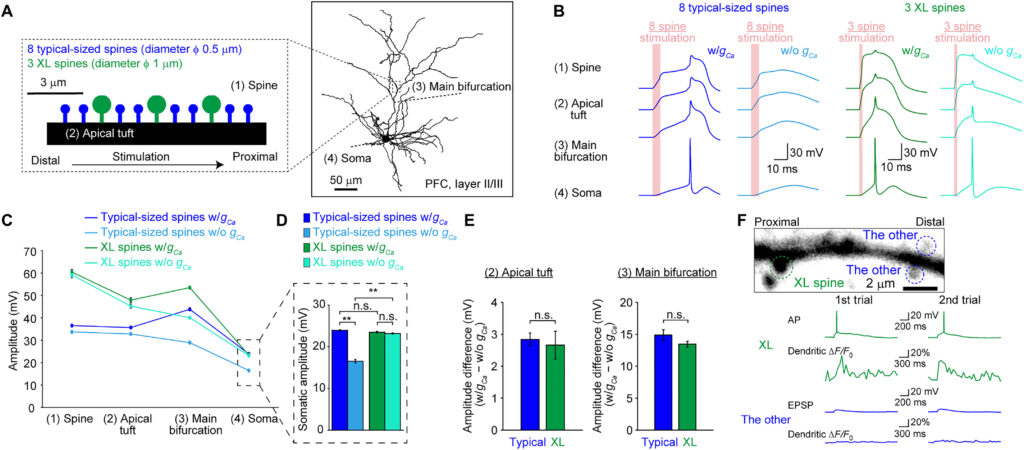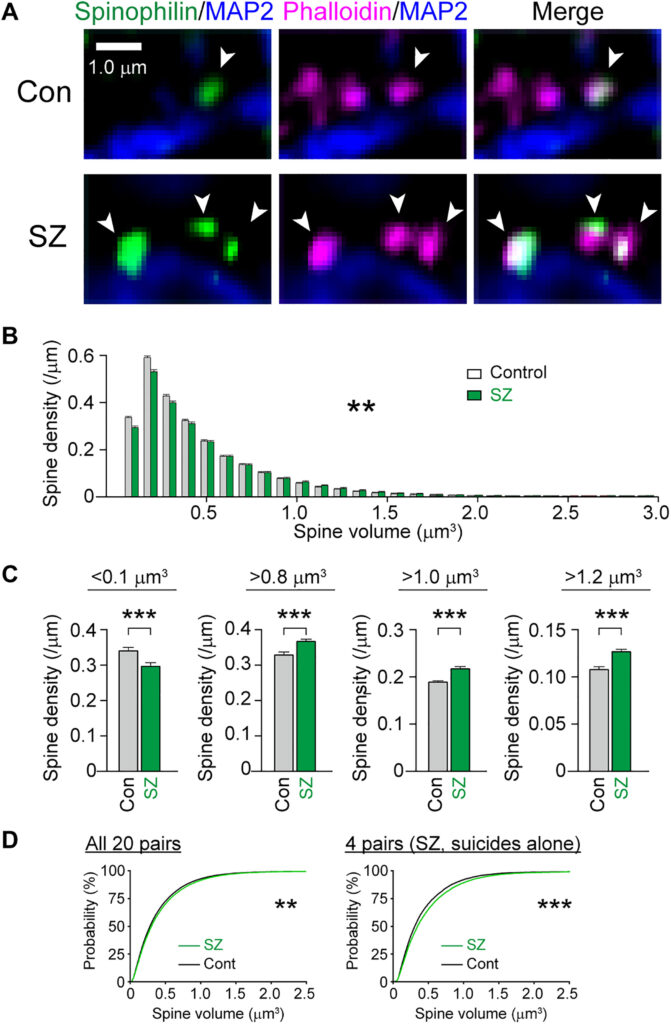SCIENCE ADVANCES 9 Jun 2023 Vol 9, Issue 23
Distorted neurocomputation by a small number of extra-large spines in psychiatric disorders (精神疾患における少数の超大型スパインによる歪んだ神経計算)
Kisho Obi-Nagata 1 2, Norimitsu Suzuki 1, Ryuhei Miyake 1, Matthew L MacDonald 3, Kenneth N Fish 3, Katsuya Ozawa 1, Kenichiro Nagahama 4 5, Tsukasa Okimura 6, Shoji Tanaka 7, Masanobu Kano 4 5, Yugo Fukazawa 8, Robert A Sweet 3, Akiko Hayashi-Takagi
Abstract
Human genetics strongly support the involvement of synaptopathy in psychiatric disorders. However, trans-scale causality linking synapse pathology to behavioral changes is lacking. To address this question, we examined the effects of synaptic inputs on dendrites, cells, and behaviors of mice with knockdown of SETD1A and DISC1, which are validated animal models of schizophrenia. Both models exhibited an overrepresentation of extra-large (XL) synapses, which evoked supralinear dendritic and somatic integration, resulting in increased neuronal firing. The probability of XL spines correlated negatively with working memory, and the optical prevention of XL spine generation restored working memory impairment. Furthermore, XL synapses were more abundant in the postmortem brains of patients with schizophrenia than in those of matched controls. Our findings suggest that working memory performance, a pivotal aspect of psychiatric symptoms, is shaped by distorted dendritic and somatic integration via XL spines.
ヒトの遺伝学的研究は、精神疾患におけるシナプスの関与を強く支持している。しかし、シナプスの病理と行動の変化を結びつけるトランススケールの因果関係は不明である。この疑問を解決するため、われわれは、統合失調症モデル動物として検証されているSETD1AとDISC1をノックダウンしたマウスの樹状突起、細胞、行動に対するシナプス入力の影響を調べた。両モデルとも、超大型(XL)シナプスの過剰発現を示し、樹状突起と体性統合を超直線的に誘発し、その結果、神経細胞の発火が増加した。XLスパインの発生確率はワーキングメモリと負の相関があり、超大型スパインの発生を光で防ぐとワーキングメモリ障害が回復した。さらに、統合失調症患者の死後脳では、XLシナプスがマッチさせた対照群よりも多く存在していた。この結果は、精神症状の極めて重要な側面であるワーキングメモリーのパフォーマンスが、超大型スパインを介した樹状突起と細胞体の統合の歪みによって形成されていることを示唆している。
巨大スパインに基づく統合失調症の病態生理の新仮説-神経細胞の“シナプス民主主義”の崩壊-
理化学研究所(理研)脳神経科学研究センター 多階層精神疾患研究チームの小尾(永田)紀翔 客員研究員、林(高木)朗子 チームリーダーらの国際共同研究グループは、ごく少数の非常に強いシナプス[1](巨大スパイン[2])が統合失調症[3]の責任病態生理である可能性を発見しました。

(b) ヒト死後脳では、統合失調症患者群は健常対照群よりも巨大スパインの数が多い。https://www.riken.jp/press/2023/20230610_1/
Introduction
統合失調症(SZ)や神経発達障害(NDD)などの精神疾患は、世界的な健康負担の主な原因となっている。これら2つの疾患は異なるものであるが、発達に起因し、神経結合の変化に関連するいくつかの臨床的特徴を共有している。例えば、ワーキングメモリ障害はSZの最も一般的な症状の一つであり、これはデフォルトモードネットワーク、特に内側前頭前皮質(PFC)における高い機能的結合性と相関している。さらに、大脳皮質と視床の過接続は、ワーキングメモリー(WM)能力の障害と関連しており、SZ患者の臨床転帰をより悪くすることを予測する。NDDの主要なタイプである自閉症スペクトラム障害(ASD)に関しては、機能的結合が高いほど症状の重症度が高いことが予測される。このような証拠が積み重ねられているにもかかわらず、シナプスレベルや細胞レベルで歪んだ結合性の根底にあるメカニズムは依然として解明されておらず、これらの障害の治療標的が曖昧になっている。
最先端のゲノム研究により、疾患に関連する遺伝子変異がこれら2つの疾患間で共有されていることが明らかになっており、これらの変異は興奮性シナプスネットワークにかなり蓄積している。大脳新皮質の興奮性シナプスのほとんどは樹状突起のスパイン上にあり、死後脳を用いた病理学的研究から、SZ患者では小さいスパインが選択的に失われ、スパインの体積分布が大きい方にシフトしていることが明らかになっている。しかし、ヒトにおけるシナプスの機能研究には限界があるため、精神疾患におけるスパイン異常の因果関係や病理学的メカニズムは不明なままである。
そこでわれわれは、エフェクトサイズが大きい2つの疾患関連遺伝子変異に注目した。ひとつは、H3K4メチルトランスフェラーゼの活性ドメインをコードするSETD1Aの機能喪失(LoF)である。この遺伝子は現在、SZおよびNDD患者においてゲノムワイドに有意なLoF変異が再現される唯一の遺伝子である。もうひとつはDISC1のLoF変異体であり、染色体転座によりスコットランドの大家族にさまざまな精神障害が分離することが発見された(21)。NDD患者の全ゲノム配列決定により、DISC1遺伝子のエクソン欠失が同定されたが、この欠失は15,000人の対照群では検出されなかった。我々は、SETD1Aヘテロノックアウト(hKO)マウスおよびDISC1コンディショナルノックダウン(cKD)マウスのシナプス入力、神経細胞計算、ワーキングメモリーパフォーマンスの関係を、単一スパインの2光子グルタミン酸アンケージング、パッチクランプ電気生理学的解析、生物物理学的シミュレーション、行動解析、およびエクストララージ(XL)スパインの光学的収縮法(optical shrinkag)を用いて明らかにすることを目的とした。さらに、ヒト患者におけるシナプス病態との関連性を明らかにするために、SZ患者とそれにマッチした対照群との死後脳におけるスパインの構造解析を行った。

(A and B) Histograms of pyramidal neuron spine head diameters in layers II/III of the PFC in SETD1A hKO (A) and DISC1 cKD mice (B) at P60. n = 6 dendrites per condition. (C to E) Intra-spine Ca2+ events, as indicated by the fluorescence change of Cal-520 dye upon single-spine glutamate uncaging. A representative image is shown (C). Relationship between spine diameter and integrals of the intra-spine Ca2+ event fitted a sigmoidal function (red approximate line) rather than a linear function (gray approximate line). Fitting was supported by the corrected Akaike information criterion (AICc), in which the model with the lowest AICc is considered to be most appropriate (D). Large intra-spine Ca2+ event in XL spines (E). (F and G) Probability of XL spines in (A) and (B). (H) Pyramidal cells reconstructed from high-magnification images. Control (SETD1A hKO) and control (DISC1 cKD) indicate wild-type littermate of SETD1A hKO and wild-type with control short hairpin RNA, respectively. XL spines are represented by red dots. (I to L) Significant clustering of XL spines in the experimentally observed cells (n = 9) of SETD1A hKO (J) and DISC1 cKD mice (L), as revealed by comparisons with randomly distributed virtual cells (n = 45). No clustering of XL spines was observed in control mice (I) and (J). (M and N) Spine densities of SETD1A hKO (M) and DISC1 cKD mice (N). (O and P) miniature excitatory postsynaptic currents in acute slices of the PFC. Representative traces (O), cumulative frequency plots (P), and amplitudes (P) of control and SETD1A hKO mice. n = 13 cells per condition. See also table S1 for measurements and statics. *P < 0.05, **P < 0.01, ***P < 0.001. n.s., not significant.

(A) Simulated sites for determining membrane potentials using the NEURON platform (1) inside the spine, (2) apical tuft, (3) main bifurcation, and (4) soma. (B) Membrane potentials after the coactivation of spines (eight normal-sized spines and three XL spines) at each segment were stimulated, and differences between intact (w/ gCa) and zero (w/o gCa) conductance of VDCCs were compared. (C and D) Elevation of membrane potential from baseline upon activation of three XL spines or eight typical-sized spines (C). Somatic membrane potential of XL spine and normal-sized spine synaptic depolarization (D). (E) Difference in membrane potentials between intact and zero gCa in the dendrite. n = 8 dendrites. Parameters used in the NEURON simulation are available in table S2 (57, 58). (F) Induction of AP by a single XL spine but not its neighboring normal-sized spines. Dendritic Ca2+ transients and somatic EPSPs upon glutamate uncaging are shown. **P < 0.01. See also table S1 for measures and statics.

(A) Representative images of dendrites in the primary auditory cortexes of human of SZ participants and matched controls. Arrowheads: Protrusions identified as “spines” using deep learning. (B) Histograms of spine volumes in 20 SZ participants and 20 matched control participants. (C) Comparison of spine densities according to spine volume thresholds of >0.8, >1.0, and >1.2 μm3. (D) Cumulative probability showing the significant increase of larger spines in SZ participants. Comparison between 20 SZ participants and matched controls (left), and between patients with SZ who died of suicide and matched controls (right). **P < 0.01, ***P < 0.001. See also table S1 for measures and statics.
Discussion
シナプス病態と精神疾患との因果関係を明らかにすることは、ヒトにおけるシナプスの機能的研究が不足しているために困難であった。そこでわれわれは、SETD1AとDISC1遺伝子の破壊的LoF変異という、エフェクトサイズが大きい2つの疾患関連遺伝子変異に注目した。どちらのモデルマウスも超大型スパインの過剰発現を示し、XLスパイン内部でのNMDAR依存的な自己再生電位発生を介して、神経細胞の発火を超線形に増加させた。特に、SZ患者の死後脳では、XLスパインの確率が有意に上昇していた。最後に、SETD1A hKOマウスとDISC1 cKOマウスでは、XLスパインの確率がワーキングメモリーと負の相関を示し、発生過程におけるXLスパインの生成を光で防ぐことで、SZモデルにおけるワーキングメモリーの劣化を救うことに成功した(図7)。
SETD1AおよびDISC1モデルマウスでは、XLスパインのトランススケールな因果性が証明されたが、これは障害のすべての集団の一般原則を説明するものではなかった。SETD1AおよびDISC1モデルマウスにおけるXLスパインの顕著な増加に比べ、SZ患者20人と対照群20人の死後脳における群間差は緩やかであった。これは種差のためかもしれない。しかし、統計的有意性は自殺で死亡した患者でより顕著であったことを考えると、障害の異質性が群間差を薄めたのかもしれない。マウスモデルでは、ワーキングメモリー障害を伴うSZモデルとして認められているNR1 KDマウスやカルシニューリンノックアウトマウス(50)でも、大型スパイン数の有意な増加が観察されている。母体免疫活性化マウスやCx3cr1ノックアウトマウスは、いずれもNDD動物モデルであるが、野生型同腹子よりも有意に高いmEPSC振幅を示し、これはこれらのモデルにおいて大型スパインが過剰に発現していることを示している。これらの疾患の病因が異質であることから、過剰な大型スパインの病的発現を制御する分子メカニズムは、おそらくモデル特異的であろう。しかし、大型スパインの過剰発現が計算の歪みに及ぼす機能的役割は、これらの疾患において共通している可能性がある。従って、特定のサブセットの疾患では、XLスパインによる歪んだ結合が原因である可能性があり、機能的結合パターンと遺伝子型に基づいて患者を層別化することで、各サブタイプに対するメカニズム指向の治療戦略が可能になるかもしれない。
b11ff96cf386a7b22b5ab435e015a58f